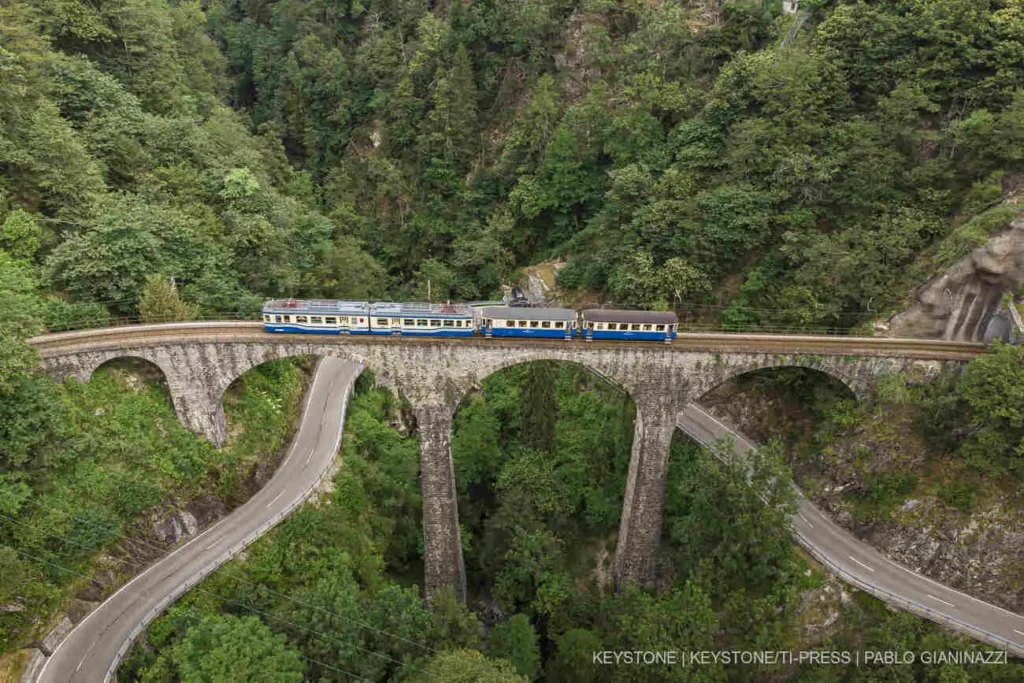Mi., Nov. 22nd 2023
Its winding route through the valley of a hundred valleys is one of the most beautiful that can be explored on rails: We are talking about the Centovalli Railway. On November 25, the “Centovallina”, as it is affectionately known in Ticino, will be 100 years old.

Autumn is perhaps the best time of year to experience the Centovalli route: The sun is already low and gives the orange, yellow and dark green of the forest a warm glow. Every now and then a small church passes by the train window. And sometimes a branch brushes across the train carriage as if guided by elves. Because this little train really does travel through the forest.
No one is in a hurry in these quiet valleys between Domodossola in Piedmont and Locarno. Neither the train, which squeaks in the bends as it takes the seemingly arduous first ascent towards Creggio, nor the passengers, who can hardly get enough of the landscape, the stone-built houses and the slopes, which are initially barren and become increasingly greener as they head towards Switzerland.
The birth of the Centovallina, which on the Italian side is called “Vigezzina” like the valley of the same name, was anything but easy. Originally, the line was to be part of the great transalpine route, but then the decision was made in favor of the Gotthard route. The Centovallina was built after all and is still the fastest connection between Bern and Ticino today.
With 83 bridges and 31 tunnels over a distance of 52 kilometers, the Centovallina is considered a masterpiece of engineering. However, it took 25 years from the initial idea to its realization.
One of the main promoters of the railroad was the mayor of Locarno, Francesco Balli (1852-1924). The former member of the Council of States wanted his town to participate in the upswing in the hotel industry from 1875, and this required a connection to the rail network. The Gotthard Railway Company had built a branch line from Cadenazzo to Locarno even before the tunnel opened. However, the Locarnese hinterland was hardly able to benefit from this.
In 1892, the lawyer therefore founded the “Pro Locarno e Dintorni” association with the aim of promoting tourism in the region. Seven years later, the visionary “Sindaco” submitted a concession application to the federal government and made it conditional on the Centovalli Railway being continued on the Italian side and the connection to the Simplon route being secured. On the Italian side, the teacher Andrea Testore (1855-1936) campaigned for the realization of the railroad in the Vigezzo Valley from the very beginning.
Balli’s original idea of building a railroad line parallel to the Centovalli Railway into the Maggia Valley and one along the right bank of Lake Maggiore only partially came to fruition: although the Maggia Valley Railway ran from 1907, it was replaced by buses in 1965. And the Italians showed little interest in a railroad line for the right bank of Lake Maggiore.
The “Centovalli Railway” project progressed, however, and after some back and forth on the Italian side, the Ministry of Public Works in Rome granted the construction permit in the fall of 1912.
However, with the start of the First World War in 1914, construction had to be interrupted: The Italian workers joined the army and Italy used the building material intended for the section in the Vigezzo Valley at the front.
After the end of the war, Swiss diplomats in Rome worked out an international treaty with their Italian colleagues on the operation of the railroad line. This was ratified by the Italian King Vittorio Emanuele and the Federal Council in 1919. Among other things, the agreement obliged both sides to ensure unity in technology and operation.
From 1919, construction work progressed rapidly and at the end of March 1923, a works train traveled the entire route for the first time. The railroad line was officially opened on November 25, 1923.
To this day, a ride on the Centovalli Railway is a journey in the truest sense of the word. After the Domodossola valley, the little white and blue train winds its way up numerous hairpin bends to Creggio on the edge of the Vigezzo Valley.
Spectacular views towards Italy follow before the train glides through quiet woodland to Santa Maria Maggiore. At Intragna, the little train crosses the famous viaduct and shortly afterwards offers a view of the lake, which in turn connects Italy with Switzerland and at the end of which the story of the Centovallina began.
©Keystone/SDA
